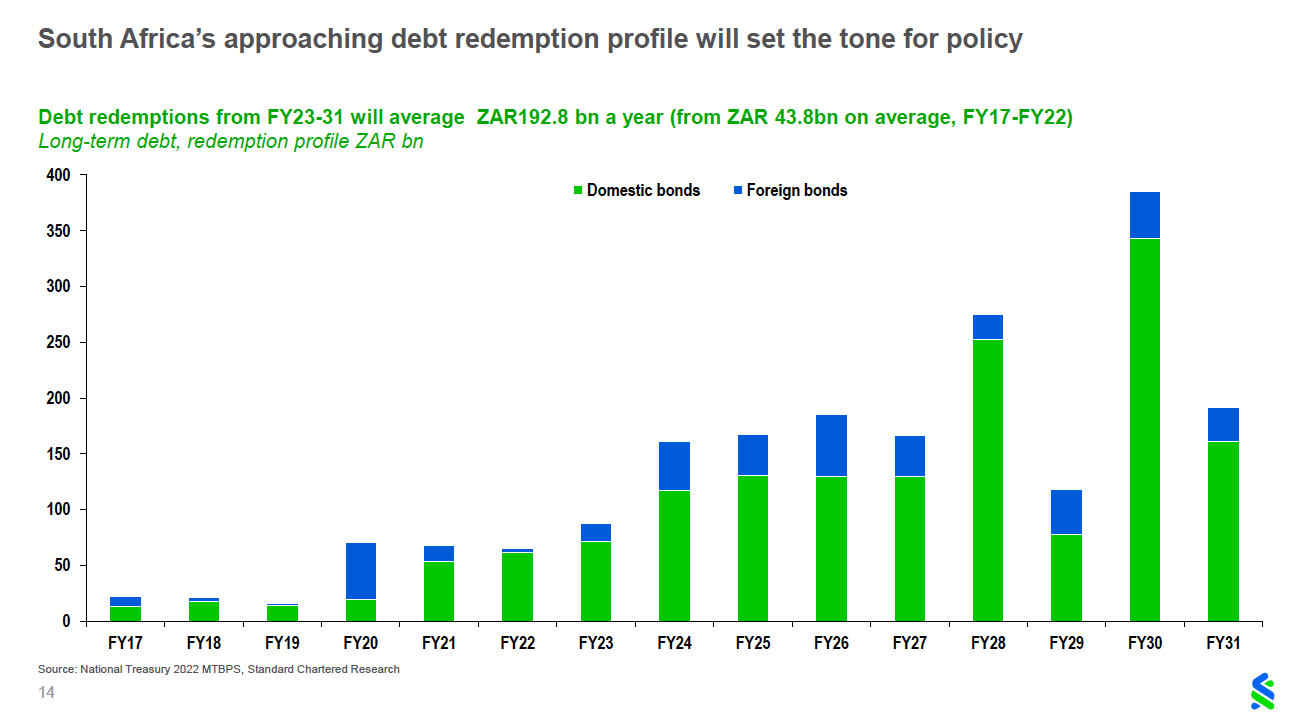ECONOMIC OUTLOOK
SA’s debt redemption profile ‘will set the tone for policy’ – economist

South Africa has no room for error on the fiscal front as its ‘debt redemption profile’ – in effect debt that is due to be redeemed – is set to soar higher. That is one of the many takeaways from a presentation given in Sandton on Wednesday by Razia Khan, Chief Africa and Asia Economist for Standard Chartered Bank.
One of the slides that stood out in the presentation – drawn from last week’s Medium-Term Budget Policy Statement – was South Africa’s long-term debt redemption profile.
From the fiscal years 2017 to 2022, this averaged R43.8-billion per year. That is set to swell to an average of R192.8-billion per year from 2023 to 2030.
In 2030 alone, it will be more than R350-billion.
As Treasury tries to rein in spending, notably by keeping a lid on the public wage bill, such a profile gives it little room for error as global financial conditions sour and risk aversion among investors rises.
The period of cheap and plentiful money is coming to an end.
“South Africa’s approaching debt redemption profile will set the tone for policy,” Khan said in her presentation.
Speaking to journalists afterward, she elaborated on this challenge in the context of South Africa’s low economic growth profile.
“Treasury is putting out a message to all stakeholders that we don’t have the room to get it wrong. Maintaining the confidence of markets is going to be important during this period of higher redemptions.
“It would come as a test for any fiscus, but it’s especially important in the context of the lower growth profile of the country compared to other emerging markets. They can say ‘we’re not going to allow spending to get out of hand … we are drawing a line in the sand’,” she said.
Visit Daily Maverick’s home page for more news, analysis and investigations
Front and centre in this emerging dilemma is the public sector wage bill.
The government has been standing firm on its 3% wage hike offer in the face of a threat by public service unions to down tools.
Government firm on 3% public sector wage increase offer — strike remains possible
Khan said Treasury has come to a realisation that it has “spent too much on public sector wages … ‘we’ve got to move to investment, not just consumption’ … and that is what has been lacking in South Africa since around 2008”.
Name your pick as to why that year sticks out, but the global financial crisis and Jacob Zuma’s political ascension certainly come to mind.
It’s also no coincidence that South Africa’s economic growth rates slowed dramatically from that time, while its debt burden soared, leaving Treasury with its current debt redemption profile at a time when the economy is just sputtering along instead of expanding at a brisk pace.
“It’s not the best use of South Africa’s resources, because creating a higher expenditure bill to take care of those who are fortunate enough to be hired does nothing for growth of the broader economy. There is an equality argument there as well,” Khan said.
“What can you do most effectively with the way spending is used to boost prospects for all? If you are spending on infrastructure, you are boosting growth prospects. And there is a much greater likelihood that most South Africans will likely get some benefit from that.
“If you are only spending in a very narrow way on public sector salaries, well, it’s good for those in the public sector.”
The message: it’s the infrastructure, stupid – and South Africa has been falling behind this curve for many years.
From pothole-littered roads to Eskom to Transnet to critical water networks, the underlying infrastructure needed to support faster rates of (hopefully) job-generating economic growth is just not there.
Instead, much has been wasted on the wage bill for a “public service” that is hardly worthy of the name. It’s simply been a bad investment, and one often linked to the corrosive influence of ANC patronage networks.
“What the South African economy clearly needs is growth. And a few years of better growth will do so much for confidence that it will open up all sorts of fiscal possibilities. And it’s absolutely important to grow for the investment rather than the consumption,” Khan said.
“We have had years of consumption leading expenditure growth, and look what growth record it has to show for it,” she added.
Indeed, the official growth forecast for 2022 is a meagre 1.9%, tapering to 1.6% over the medium term. And since 2014, it has been lower than 2% per year, with the exception of 2021’s post-pandemic bounce.
Meanwhile, public sector infrastructure spending has been on the wane.
“Public sector capital expenditure decreased by R6.1-billion (-3.0%) between 2020 and 2021, from R204.3-billion to R198.2-billion, representing the fifth consecutive year of decline,” Statistics South Africa recently noted.
Stronger rates of economic growth will help to right this listing ship of state. Increasing amounts of debt are coming due over the next decade, and urgent action is required to keep it from sinking. DM/BM



















 Become an Insider
Become an Insider
Comments - Please login in order to comment.